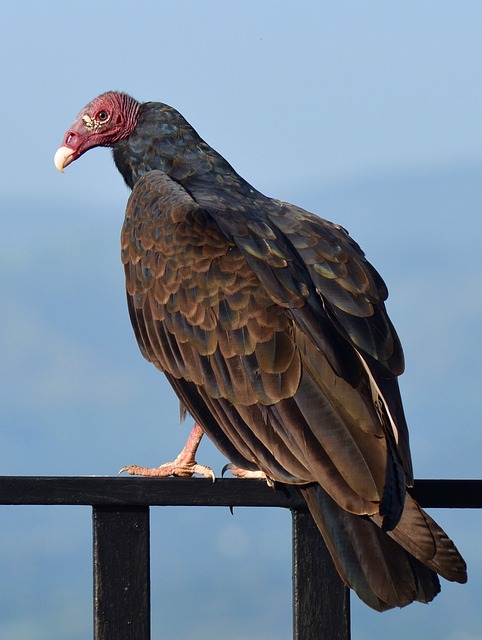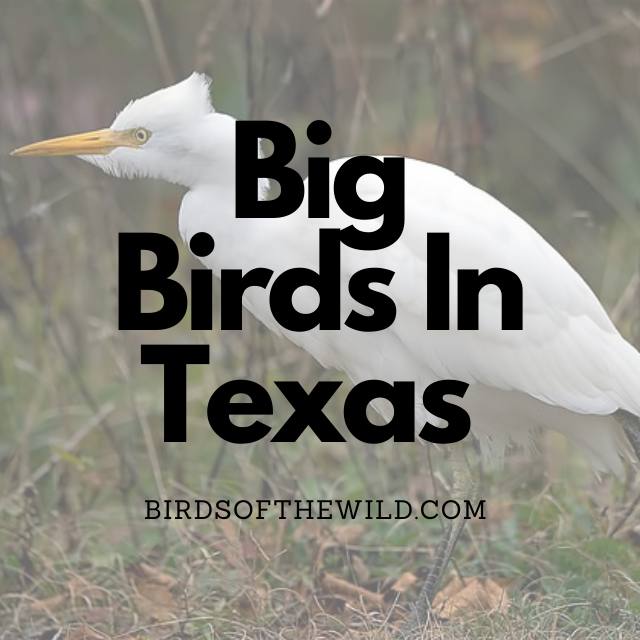Texas is home to it’s fair share of large avian lifeforms so, if you’re curious to know or learn about a few of the unique big birds in Texas, continue reading as I’ll be covering them for you in the remainder of this article.
- Bald Eagle
- Red Tailed Hawk
- Great Egret
- Sandhill Crane
- Great Horned Owl
- Turkey Vulture
- Cattle Egret
7 Big Birds In Texas
1. Bald Eagle (Haliaeetus Leucocephalus)

- Size: 90 – 108cm
- Weight: 3 – 6.3kg
- Wingspan: 180 – 250cm
Blad eagles can be found in Texas throughout their non-breeding season although the odd few further north may remian present in the state through the summer breeding months.
A bald eagle’s plumage consists of dark brown around its wing and body, with white feathers on its tail and head along with the trademark yellow beak and feet. Both male and female bald eagles look relatively the same.
As for where you can find these eagles, it will often be around lakes and reservoirs with lots of fish and surrounding forests. You’ll often find them around unfrozen lakes and hunting along coastlines, reservoirs, and rivers during the winter months
These eagles are birds of prey meaning they hunt other birds, medium sized mammals like rabbits, hares, other animals like reptiles, fish and even eat carrion when their options are limited. Sometimes bald eagles are recognised as fish eagles as their diet consists of fish and as meat is the only thing they eat these eagles would ultimately be regarded as carnivores too.
Blad eagles can live for around 20 years in the wild.
2. Red Tailed Hawk (Buteo Jamaicensis)

- Size: 45 – 60cm
- Weight: 1.25 – 1.47kg
- Wingspan: 100 – 150cm
You’ll be able to spot red tailed hawks in Texas all year round.
Red tailed hawks are recognised by their brown torso and wings, white breast and red tails. The main difference between the male and females is that the females are a third larger than the males.
These red tailed avians spend their time at a variety of places within the state including deserts, grasslands, forests, agricultural fields and urban areas.
Red tailed hawks are carnivorous birds of prey where they feed on small mammals, rodents, other smaller birds, fish and even carrion.
In the wild red tailed hawks are known to live between 15 – 20 years whilst captive red tails can live on the upper end of that spectrum around 20 years.
3. Great Egret (Ardea Alba)

- Size: 80 -100cm
- Weight: 0.7 – 1.5kg
- Wingspan: 130 – 170cm
You’ll be able to find great egrets in Texas all year round around the eastern/southern part of the state, they will generally be around central and the eastern region of the state when breeding and will make their passage through the state on the western region of Texas.
Great egrets are recognised by their extremly long necks, yellow bill, long black legs and mostly white plumage. Both males and females look very similar with the males being generally larger than the females.
Great egrets spend the majority of their time within marshes, ponds, shores and mud flats.
As for what they eat, it includes primarily consume fish along with crustaceans, amphibians, and small mammals. They will also forage around open areas.
Great egrets tend to live for around 15 years in the wild and around 22 years in captivity.
4. Sandhill Crane (Grus Canadensis)

- Size: 91 – 151cm
- Weight: 2.72 – 6.34kg
- Wingspan: 150 – 190cm
Sandhill cranes are mostly winter residents within Texas but, tend to use the eastern part of the state as one of their passgaes to mirgrate through.
Sandhill cranes whether the lesser or greater variant are recognised by their gray and brown plumage, their long neck and legs as well as the red spot on their face. They also have a jet black beak. Males are generally bigger than the females whilst the females don’t have any red spots near the eyes and beak.
These cranes tend to spend the majority of their time at open habitats within small bogs, marshes, and prairies. They will also build nests within the same areas they inhabit, but ideally would want the area to be isolated.
Sandhill cranes eat mostly seeds, grains, insects and small animals like worms, mice, small birds, snakes, lizards, frogs and crayfish.
These cranes have a lifespan that extends upto 20 years in the wild.
5. Great Horned Owl (Bubo Vrginianus)

- Size: 57 – 63cm
- Weight:1 .4 – 15kg
- Wingspan: 1.35 – 1.5m
Great horned owls can be spotted in Texas year round as it’s a permanent residence of theirs.
These large horned owls are recognised by their brown/gray plumage with their defining feature being the tuft of feather on the top of their head resembling a horn or ear like feature. Male and female great horned owls look relatively the same with the females slightly larger in size.
At night these birds will perch on a branch or a tall building to look around for prey and once the desired prey has been found they will fly towards it with folded wings, grab the prey with their talons piercing through their body and in most cases killing them immediatley.
As for what these birds eat it includes smaller prey like rodents, frogs or scorpions. Even other larger predators like geese, ducks, hawks, and smaller owls can be eaten by these carnivorous birds.
Great horned owls are most commonly found in deserts, wetlands, forests, grasslands, backyards, cities and they can also be found in semi-open habitats between the Arctic and the tropics.
As for a great horned owls lifespan, it can be anywhere from 15 -25 years.
6. Turkey Vulture (Cathartes Aura)

- Size: 62 – 81cm
- Weight: 1.5 – 2 kg
- Wingspan: 1.6 – 1.8m
These vultures can be found in the southeast and west part of Texas year round whilst in the remainder of the state you’ll spot these birds when they’re breeding. This will include the spring and summer months.
Turkey vultures have a plumage that is mostly brownish/black in color with silver/gray lining on the underside of their wings adding a contrast to their overall appearance. The face is pink/red with elements of black on the head topped of with a pale white beak.
These scavengers are mono-morphic so they do look the same with the only differentiating aspect being their sexual organs.
Turkey vultures are scattered throughout north America where they can be found staying within open and forested habitats where they will also stay within lower elevation mountain ranges.
Carrion is a turkey vultures primary food source but, they do also eat dead reptiles, birds, amphibians and invertebrates. As a whole these vultures do prefer fresher carrion but, like other vultures they can consume the same carcass over several days.
Turkey vultures are known to live for around 16 years in the wild and up to 30 years in captivity.
7. Cattle Egret (Bubulcus Ibis)

- Size: 45 – 50cm
- Weight: 270 – 512 grams
- Wingspan: 82 – 95cm
You’ll be able to find cattle egrets in the southern and eastern border of the state year round whilst in the remainder of the state you’ll find these big birds there when they happen to breed.
Cattle egrets are recognised by their mostly white plumages, with hints of orange around the head and chest, coupled with 2 yellow legs and a yellow beak. Females look very similar to the males but, are slightly smaller and have smaller breeding plumes than the opposite gender.
As for where you’ll be able to find these egrets, they will often reside by open habitats, wetlands, grasslands and woodlands generally following cattle around.
Cattle egrets generally tend to eat insects, worms, reptiles, frogs and mice.
In regards to lifespan, a cattle egret is known to live for around 10 years in the wild.
Amhil Khan, a dedicated nature enthusiast and the founder of BirdsOfTheWild.com, is a passionate advocate for the captivating world of avian wonders. With a deep-seated curiosity about the intricate lives of birds, Amhil’s journey began as a fascination and has evolved into a mission to inspire others to appreciate and protect these magnificent creatures.
Amhil’s love for birds led to the creation of Birds of the Wild, a platform where his expertise in ornithology, coupled with his captivating storytelling, provides readers with an immersive and educational experience. Through his lens and words, he captures the essence of birds in their natural habitats, offering a glimpse into their behaviors, migrations, and the ecosystems they inhabit.

